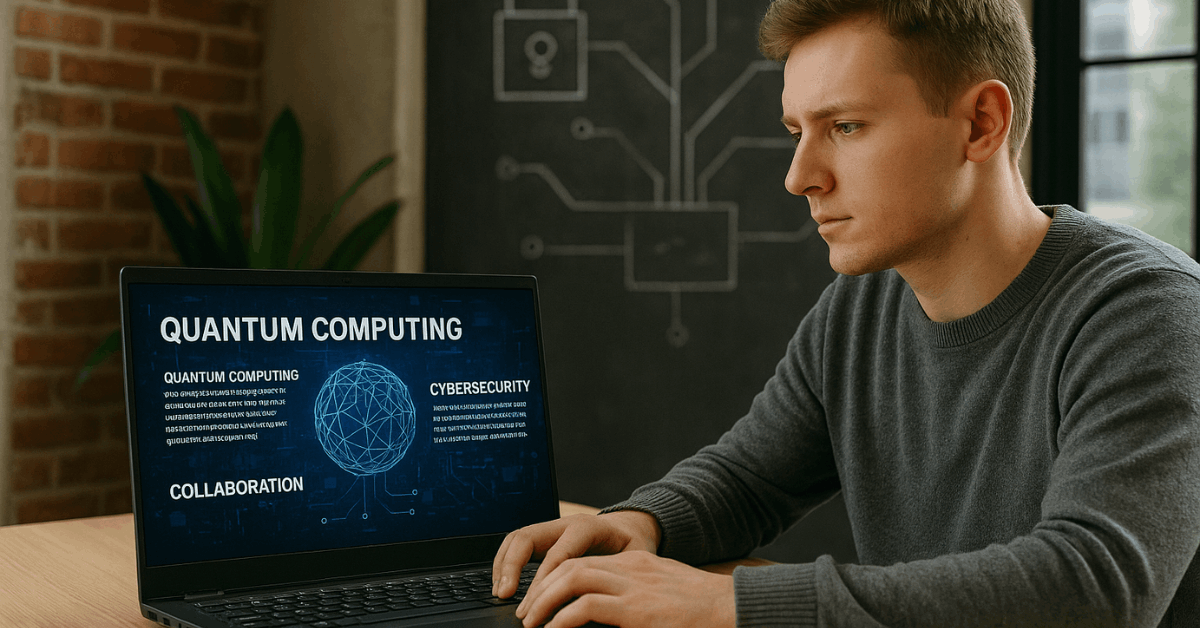Quantum computing is advancing faster than most expected. It has the power to disrupt every system that depends on encryption.
As these machines evolve, current cybersecurity methods may become obsolete. You need to understand what’s changing and how to adapt.
What Is Quantum Computing?
Quantum computing is not an upgrade of current systems — it’s a complete shift. Unlike traditional computers that use bits, quantum computers use qubits.

These qubits can exist in multiple states at once due to superposition. Combined with entanglement, this gives quantum computers their massive parallel processing power.
This enables them to solve complex problems much faster than classical machines. It’s this very power that introduces new risks.
Current Cryptography and Its Limitations
Most of today’s security relies on problems that are hard to solve with classical computers. Encryption methods like RSA and ECC are strong because factoring large primes or solving discrete logarithms is time-consuming.
Quantum computers, however, can solve these problems quickly using Shor’s algorithm. This means encrypted emails, transactions, and communications could be exposed.
AES encryption is more resilient but may still be vulnerable depending on key size. You should not assume current standards are safe for long.
Quantum Threats to Cybersecurity
Cybersecurity will face a major test once scalable quantum machines arrive. Attackers may already be storing encrypted data, waiting for the tools to decrypt it later.
This is known as a Harvest Now, Decrypt Later strategy. Encrypted backups, VPN sessions, and medical records are at risk.
These systems may seem secure today but won’t be tomorrow. Planning ahead is no longer optional.
What Is Post-Quantum Cryptography (PQC)?
To counter quantum threats, researchers are developing encryption that resists quantum attacks. This is known as Post-Quantum Cryptography (PQC).
It uses algorithms that cannot be broken even with quantum computers. NIST has selected strong candidates like CRYSTALS-Kyber and Falcon.
These can replace RSA and ECC in systems that require long-term security. Migration to PQC must begin now to stay ahead.
Quantum Key Distribution (QKD)
QKD is another layer of defense using quantum mechanics. It allows two parties to share encryption keys securely.
If an attacker tries to eavesdrop, the system will detect the disturbance. This makes QKD unbreakable in theory.
However, it requires special hardware and infrastructure, limiting its use to specific networks. Still, it offers a glimpse into future-proof communication.
What Businesses Should Do Now?
If your organization handles sensitive data, you need to act now. Begin with a cryptographic inventory to identify where RSA and ECC are used.
Analyze which data must remain secure for 10+ years. Start integrating PQC solutions or partnering with vendors who support them.
Regularly monitor updates from NIST and other cybersecurity bodies. Delay increases long-term risk.
Can Quantum Computing Improve Cybersecurity Too?
Quantum tools won’t only break systems — they may also enhance defenses. Quantum-generated random numbers are more secure for cryptographic keys.
Machine learning models running on quantum systems could detect threats faster. Quantum-based sensors might help prevent physical tampering.
While these benefits are years away, they offer hope. Security will evolve, not just break.
Ethical and Geopolitical Implications
Quantum breakthroughs are triggering a global race. Whoever gains quantum supremacy first may exploit global data. This could impact diplomacy, economics, and national security.
Ethics and international agreements are needed to control misuse. Transparency and collaboration are key. The world must prepare together.
Role of Government and Regulation
Governments will play a key role in managing quantum risks. Regulatory frameworks need to evolve alongside technological changes.
New standards for encryption and compliance must be established. Funding must support academic and private-sector quantum R&D.
Intelligence agencies should collaborate to reduce global instability. Policy and enforcement must keep pace with quantum breakthroughs.
How Academia Is Contributing to Quantum-Safe Systems?
Universities are central to the development of post-quantum algorithms. Research centers are working with governments to test quantum protocols.
Academic partnerships with tech firms are accelerating progress. Education in quantum principles is expanding to meet future demands.
Students are being trained to enter quantum security roles. Innovation will depend heavily on academic input.
Public Awareness and Cyber Hygiene in the Quantum Era
Users need to be aware of the changes quantum computing brings. Cyber hygiene must evolve to account for future threats.
Individuals should use platforms that adopt quantum-safe tools. Public campaigns can help demystify quantum risks.
Organizations should educate staff on transitioning encryption practices. Awareness is a critical part of resilience.
Industry-Specific Risks and Preparations
Different sectors will face different quantum challenges. Financial services must protect long-retention records and transactions.
Healthcare needs to secure patient data for decades. Government systems are critical targets with long-term value.
Cloud service providers must ensure client data remains confidential. Each industry should tailor its strategy based on sensitivity and data lifetime.
The Transition Period: Hybrid Cryptographic Systems
Before full PQC adoption, hybrid cryptographic models offer protection. These systems combine classical and quantum-safe algorithms.
They provide flexibility while testing PQC performance and reliability. Hybrid models ease the migration and reduce failure risks.
They also allow time for broader infrastructure updates. This approach will be a key part of transition planning.
Challenges in PQC Implementation
Migrating to quantum-safe encryption isn’t simple. Existing infrastructure may not support new algorithms without major upgrades.
Performance issues could arise due to larger key sizes. Developers will need new libraries, protocols, and training.
Compatibility with legacy systems could delay deployment. These challenges make early planning essential.
Quantum Readiness Metrics and Benchmarks
Organizations need tools to measure quantum readiness. Benchmarks help assess cryptographic exposure across systems.
Metrics can track progress toward full PQC adoption. Internal audits should include quantum impact reviews.
Readiness scores will guide security investments. Monitoring these indicators keeps your risk under control.
Collaboration Between Tech Companies and Governments
Public-private partnerships are essential for quantum resilience. Tech companies can offer scalable solutions and pilot deployments.

Governments provide regulatory guidance and national infrastructure. Joint task forces can speed up standards development.
Collaboration ensures better adoption and security alignment. Collective action is key to staying ahead of threats.
Final Thoughts: Don’t Wait for the Quantum Threat to Arrive
Quantum computing is no longer science fiction. Its progress could upend the security landscape in less than two decades.
Current encryption will not hold against quantum power. Start learning, adapting, and upgrading your systems now. Cybersecurity in the quantum era demands urgency and foresight.



